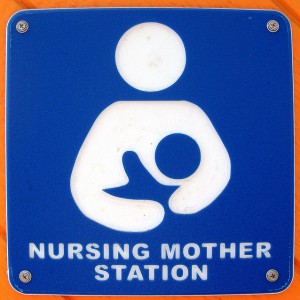Break Time for Nursing Mothers - It's the Law!
By: Sharon Muza, BS, LCCE, FACCE, CD/BDT(DONA), CLE | 0 Comments
By Kathleen Marinelli, M.D.

creative commons licensed ( BY-SA )
http://creativecommons.org/licenses/by-sa/2.0
In honor of Mother's Day, which is coming up this weekend, I thought it would be important to talk about a challenge that many mothers face after having a baby. Returning to work and continuing to breastfeed their baby. Many countries offer a generous leave for new mothers, but here in the USA, it is not uncommon for a new mother to find herself back at work 6 weeks after giving birth. So many challenges face these women, and the added pressure of work environment that is unsupportive of the breastfeeding relationship and the mother's need to have a private, appropriate place to pump and store her milk while separated from her baby is not only critical, it's the law. Today on Science & Sensibility, Kathleen Marinelli, M.D, the Chairwoman of the United States Breastfeeding Committee updates us on the "Break Time for Nursing Mothers" law and shares resources for clients and students who are returning to work and breastfeeding. While this day seems far away to families sitting in a childbirth class, making space for this discussion and sharing resources can help women to continue to breastfeeding smoothly after returning to work. - Sharon Muza, Community Manager, Science & Sensibility.
With more than half of women with infants employed, simple workplace accommodations are critical for breastfeeding success. By helping moms understand their rights as a breastfeeding employee and plan for their return to work, childbirth educators, doulas, health care providers and lactation care providers can support a successful transition so that working moms are supported to reach their personal breastfeeding goals.
The federal "Break Time for Nursing Mothers" law requires employers to provide break time and a private place for hourly paid employees to pump breast milk during the work day. The United States Breastfeeding Committee's Online Guide: What You Need to Know About the "Break Time for Nursing Mothers" Law compiles key information to ensure every family and provider has access to accurate and understandable information on this law.
Key Facts about the "Break Time for Nursing Mothers" Law:
• Who is covered: The law applies to nonexempt (hourly) employees covered by the Fair Labor Standards Act.
• Space: Employers are required to provide a place that is not a bathroom. It must be completely private so that no one can see inside. Employers are not required to create a permanent dedicated space for breastfeeding employees. As long as the space is available each time the employee needs it, the employer is meeting the space requirements.
• Time: The law requires employers to provide "reasonable" break time, recognizing that how often and how much time it takes to pump is different for every mother. Employees should consider all the steps necessary to pump, including the time it will take to gather pumping supplies, get to the space, pump, clean up, and return to their workspace. Employers must provide time and space each time the employee needs it throughout her work day.
• Enforcement: The U.S. Department of Labor's Wage and Hour Division (WHD) is responsible for enforcing the "Break Time for Nursing Mothers" law. If an employer refuses to comply, employees can file a complaint by calling the toll-free WHD number 1-800-487-9243.
• Small Businesses: All employers, regardless of their size or number of employees, must comply with the "Break Time for Nursing Mothers" law. Following a complaint from a breastfeeding employee, businesses with fewer than 50 employees may be able to apply for an undue hardship exemption. To receive an exemption for that employee, the employer must prove that providing these accommodations would cause "significant difficulty or expense when considered in relation to the size, financial resources, nature, or structure of the employer's business." Until they are granted an exemption by the Department of Labor, they must comply with the law.
• State laws: Employees who are not covered by the "Break Time" law may be covered by a state law. Contact your state breastfeeding coalition for help understanding the breastfeeding laws where you serve.
The "Break Time for Nursing Mothers" law was an important victory for families, but breastfeeding success shouldn't depend on a mom's job type. The Supporting Working Moms Act would expand the existing federal law to cover approximately 12 million additional salaried employees, including elementary and secondary school teachers. We can all help make this happen! Use USBC's easy action tool to ask your legislators to cosponsor the Supporting Working Moms Act with just a few clicks. Twelve million employees are counting on us! As Surgeon General Regina Benjamin advised us, "Everyone can help make breastfeeding easier."
We know that workplace lactation support is a "win-win", benefiting families, employers, and the economy, yet one of the major causes for the drop-off in breastfeeding rates is the lack of effective, reasonable workplace accommodations when mothers return to work. Employers that provide lactation support experience an impressive return on investment, including lower healthcare costs, absenteeism, and turnover rates, with improved morale, job satisfaction, and productivity. The retention rate for employees of companies with lactation support programs is 94%, while the national average is only 59%!
Breastfeeding and working is not only possible, it's good for business. Find additional information and resources in USBC's Online Guide: What You Need to Know About the "Break Time for Nursing Mothers" Law and help spread the word about this valuable new resource with your clients by sharing this link: www.usbreastfeeding.org/workplace-law.
Moms, babies and employers everywhere will be glad you did!!
Important links and information:
• Online Guide: What You Need to Know About the "Break Time for Nursing Mothers" Law
• Action Alert: Supporting Working Moms Act
• Directory of State, Territorial, and Tribal Breastfeeding Coalitions
• United States Department of Labor Employee Rights Card
• Wage and Hour Division Break Time for Nursing Mothers Webpage
• The Business Case for Breastfeeding
Do you talk to patients, students and clients about tips for successful re-entry into the workforce while still breastfeeding a baby? What are your favorite resources to offer women so they know their rights and understand the responsibilities of their employer to assist them in continuing to express breastmilk for their baby. If you are not mentioning this to your families, maybe you will consider how important this information is after reading today's blogpost and consider passing on these resources. - SM
About Kathleen Marinelli, M.D.
 Dr. Kathleen Marinelli is the Chair of the United States Breastfeeding Committee, an independent nonprofit coalition of almost 50 nationally influential professional, educational, and governmental organizations, that share a common mission to improve the Nation's health by working collaboratively to protect, promote, and support breastfeeding, where she represents the Academy of Breastfeeding Medicine. She is also a Neonatologist and Breastfeeding Medicine Physician at Connecticut Children's Medical Center, in the Connecticut Human Milk Research Center, and Associate Professor of Pediatrics at the University of Connecticut School of Medicine.
Dr. Kathleen Marinelli is the Chair of the United States Breastfeeding Committee, an independent nonprofit coalition of almost 50 nationally influential professional, educational, and governmental organizations, that share a common mission to improve the Nation's health by working collaboratively to protect, promote, and support breastfeeding, where she represents the Academy of Breastfeeding Medicine. She is also a Neonatologist and Breastfeeding Medicine Physician at Connecticut Children's Medical Center, in the Connecticut Human Milk Research Center, and Associate Professor of Pediatrics at the University of Connecticut School of Medicine.
Published: May 07, 2014
Tags
BreastfeedingPostpartumMaternal Infant CareBabiesUnited States Breastfeeding CommitteeGuest PostsKathleen Marinellireturn to work